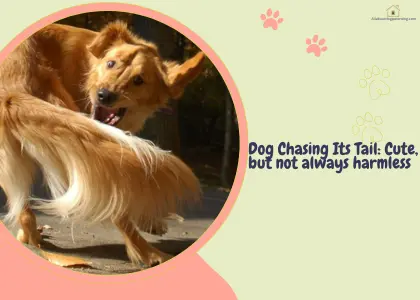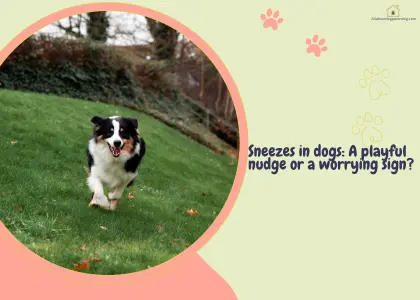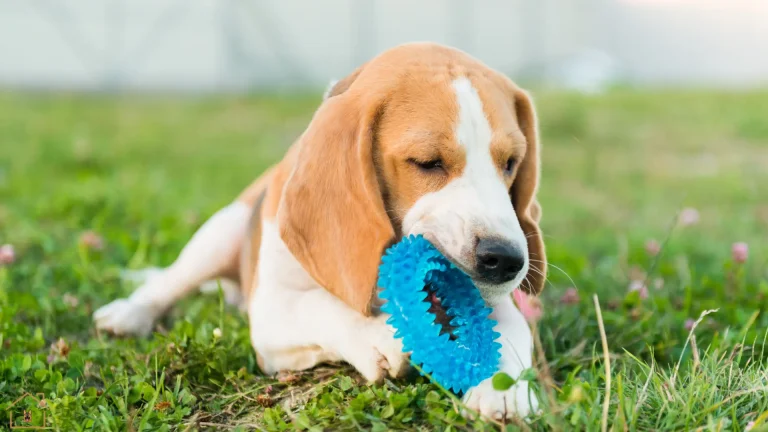Why Is My Dog Chasing Its Tail? Fun or Something Serious?
So your pet is happily spinning around chasing her tail. Looks hilarious, right? At first, even I’d dismiss it as one of those canine quirks that we don’t quite get but find endearing all the same. It was only when I noticed that my rescued GSD did this almost compulsively in certain situations that I decided to delve deeper into why dogs chase their tails. And let me tell you there can be more to the story than just a quirky habit.
If you, too, have been puzzled by your dog’s need to grab a hold of his tail, this guide is for you. Explore the different dog chasing tail meanings, as I break down playful vs. problematic tail chasing, highlight any health risks, and share tips on what to do when tail-chasing goes from cute to concerning.
When Tail Chasing Is Normal
I have seen many pups totally captivated by their wagging tails and there may come a phase where they chase it every day. This is pretty common. Veterinarian Dr. Krista Williams, BSc, DVM, explains, “Many young pups consider their tail a toy. In puppies, chasing the tail is usually a passing phase.” This playful tail chasing is part of normal dog behavior.
Sometimes, an adult dog will spin or chase in short bursts of excitement or silliness. I’ve seen almost all my dogs do it, especially when a human they love drops in or a family member returns after a long gap. If you catch yourself wondering, “Should I stop him/her?”, well, typically, you don’t need to. You might consider tossing a ball or tug toy to distract your pet, if you want, but it’s not necessary. Tail chasing is a dog being goofy and having fun, not a problem, as long as it’s occasional.
Possible Medical Causes of Tail Chasing
However, not all tail chasing is normal or harmless. Sometimes, there can be a physical reason behind it. Some common medical reasons for dog tail chasing include:
- Fleas, Ticks, or Parasites
The tail area is a common hiding spot for fleas and ticks. If your dog is itchy there, he may chase or chew his tail. Dr. Williams notes, “Dogs may chase their tails when infested with parasites like tapeworms or fleas.” Flea bites or ticks at the tail base can cause intense irritation. Such itchy dog skin irritation tail issues can make a dog chase their tail, almost obsessively. It’s not the tail they are after but an itch they are trying to scratch. Intestinal worms like tapeworms can also trigger tail-chasing, as dogs feel segments at their rear. Regular deworming and preventative measures against ticks and fleas often makes the behavior stop. Also, remember to always check your dog’s tail when you’re examining them for ticks or fleas.
- Allergies or Skin Irritation
Food or environmental allergies can make a dog very itchy around the hind end. Allergies to things like beef, dairy or pollen often manifest as skin irritation near the tail. Many dogs are actually allergic to flea saliva, so a single bite can lead to days of itching. If your dog’s tail-chasing comes with redness, bumps or bald spots at the base of the tail, consider allergies. A vet might recommend antihistamines, a hypoallergenic diet or a medicated shampoo to soothe your dog’s skin.
- Anal Gland Issues
Impacted or infected anal glands are a big culprit. Dogs have two small sacs on either side of the anus. If they get clogged, it’s extremely painful. Your dog will often nudge or bite that area for relief. Dr. Williams explains, “Impacted glands cause the dog great discomfort. He will bite and chew at his tail area.” You might even notice your dog scooting on the floor. If you suspect dog anal gland problems, see your vet. Expressing or treating the anal glands usually provides relief and stops the tail-chasing.
- Neurological Disorders
Rarely, a neurological problem can make a dog feel tingling or numbness in the tail, which leads to frantic chewing or chasing. Dr. Williams notes, “Neurologic problems could also provoke tail chewing if they alter sensation, such as making it feel tingly or numb.” For example, a tail injury or spinal issue might cause a pins-and-needles feeling. In very rare cases, seizures or other brain issues can trigger tail-chasing episodes. If the tail-chasing is sudden and you suspect a nerve or brain issue, mention it to your vet during the exam.
Behavioral Causes of Tail Chasing

Tail chasing isn’t always brought on by underlying medical issues or physical problems, they can also be an expression of behavioral issues. Many behavioral dog issues can trigger spinning, such as boredom, attention, or anxiety. The most common ones include:
- Boredom and Lack of Exercise
A bored dog might chase his tail simply for something to do. Veterinary behaviorist Rachel Malamed Behaviorist says, “If a dog is bored, frustrated or has pent-up energy, this could manifest as tail-chasing.” The cure is simple: make sure your dog gets more activity. This includes physical activities such as walks and play sessions as well as mental stimulation activities that you can even try indoors.
- Attention-Seeking Behavior
Some dogs learn that chasing their tail gets a reaction, good or bad. Malamed explains, “Tail chasing is an invitation for you to take notice and play with him. If a dog is rewarded with praise or an exciting reaction from the audience, it may be motivated to perform the behavior again.” The fix is counter-intuitive: ignore the chasing. No laughs or scolding. Give your dog attention only when he is calm. Over time, he’ll learn tail-chasing doesn’t earn attention.
- Anxiety or Stress
Stressful environments or feelings can lead to compulsive spinning. This, I discovered, was the underlying reason why my rescued GSD would go into a tail-spin every time he felt he was being left alone. Since he had been abandoned by the side of the road, he had terrible separation anxiety. After trying different approaches to help him feel calmer, here are some things that helped me break the cycle of self-soothing through tail-chasing:
- Crate training for separation anxiety so that he had a safe space to retreat to
- Calming toys and chews to redirect the nervous energy
- Keeping his environment predictable
- Plenty of mental stimulation
If you’re dealing with an anxious dog that chases his tail endlessly, these steps can help. The idea is to redirect the nervous energy into a positive outlet.
- Obsessive-Compulsive Disorder
In the most severe cases, tail-chasing is a true compulsion. Canine OCD can take over a dog’s life. Malamed warns, “In these cases, the dog is not able to be redirected, and the behavior begins to interfere with vital activities such as eating and drinking.” These dogs literally cannot stop. They will injure themselves with their tails from nonstop chewing.
Certain breeds like bull terriers, German Shepherds, Australian Cattle Dogs are genetically prone to compulsive tail-chasing. Such compulsive tail chasing in dogs goes far beyond normal play and usually requires professional help, which usually involves behavioral therapy and sometimes medication.
When Tail Chasing Becomes a Problem
It’s time to worry when tail-chasing becomes excessive. Dr. Williams says, “If your dog chases his tail more frequently or injures his tail by biting it, consult your veterinarian.” So, watch out for red flags such as tail-chasing causing,
- Sores
- Bleeding
- Hair loss
Or if your dog is so pre-occupied with their tail that they’re
- Skipping meals
- Ignoring training
- Losing sleep
Remember, excessive tail chasing in dogs is a serious dog behavioral warning sign. If your happy dog suddenly won’t stop spinning, treat it like any other health issue and seek guidance.
What to Do if Your Dog Chases Its Tail Too Much

When tail-chasing goes beyond normal goofiness, it’s time to take proactive actions. Here are some tips that can help you in stopping dog tail chasing:
- Rule Out Medical Issues
First thing, see the vet. If your dog’s spinning is new or extreme, visit a veterinarian for a full check-up. The vet will look for fleas, ticks, skin infections, injuries or anal gland problems. Remember, dogs often chew at painful areas for relief, like rubbing a sore knee. If the tail-chasing was triggered by an underlying medical issue, addressing it will immediately stop the behavior.
- Increase Exercise and Playtime
Excessive tail chasing dogs are often bored or understimulated, so adding more physical outlets for them to release their energy can help. The more you take your dog out for long walks, play fetch, and go on regular hikes, the less they’ll turn to their tails for entertainment.
- Provide Mental Stimulation
Boredom is mental as much as physical. Give your dog puzzle toys, food-dispensing chews or new tricks to learn. Malamed recommends, “Provide your dog with activity toys, puzzles and problem solving games to help relieve stress or boredom.” For example, a Kong filled with treats can keep a dog busy longer than tail-chasing ever did. Short training sessions, for even 10 minutes a day, can also stimulate their brain. A mentally stimulated dog has less time for obsessive games.
- Avoid Reinforcing the Behavior
Lastly, don’t reward the tail-chasing, no matter how cute or hilarious it looks. If tail-chasing is attention-seeking or compulsive, any reaction from you, even a negative one, can reinforce it. When you catch your dog chasing his tail, simply look away or walk off. Only praise and pet him when he’s calm. With consistent non-response to tail-chasing and rewards for other behaviors, the habit can weaken over time.
Tips to Prevent Excessive Tail Chasing
Preventing dog tail chasing is, of course, more desirable than trying to figure out how to deal with it. Of course, the sudden onset of tail-chasing obsession cannot always be predicted or ruled out. But there are measures you can take to rule out some common tail-chasing triggers, so that the issue never takes root:
- Consistent Exercise Routine: Stick to a daily exercise schedule. A tired dog is a happy dog
- Balanced Diet and Health: Feed a high-quality, balanced diet. Some dogs need extra fiber so stools stay firm and anal glands empty naturally. Supplementing vitamins may even reduce tail-chasing tendencies
- Parasite Prevention: Keep up with flea and tick preventatives and regular deworming. With fleas and worms controlled, you avoid one common itch-trigger
- Mental Enrichment and Social Time: Provide puzzle toys, playdates or training classes to challenge your dog’s mind. Regular social interaction can also curb boredom and anxiety
- Calm, Structured Environment: Establish a calm routine at home. Avoid long periods of isolation, and use calming aids if needed. A stable environment means less stress and fewer compulsive behaviors
These are straightforward dog care tips for preventing dog tail chasing. By giving your dog proper exercise, nutrition, vet care and lots of love and attention, you’ll encourage overall healthy dog behavior. That in turn keeps him focused on walks and toys, not his own tail.
FAQs About Tail Chasing in Dogs
1. Is it normal for puppies to chase their tails every day?
Yes, it’s quite normal. Puppies often chase their tails out of curiosity, playfulness, or simply because they’re discovering their own body. According to vets, most dogs outgrow this behavior as they mature. As long as the chasing is lighthearted and not obsessive, it’s generally nothing to worry about.
2. Can tail chasing be a sign of worms in dogs?
Possibly. Parasites such as tapeworms or fleas can cause itching or irritation near a dog’s rear, leading them to chew or chase their tail. If you notice frequent or intense tail-chasing, it’s best to have your vet check for parasites or skin issues to rule out an underlying health problem.
3. Do certain breeds chase their tails more than others?
Yes, some breeds are more prone to tail-chasing. For example, Bull Terriers and German Shepherds are known for compulsive tail-spinning behaviors. However, tail-chasing isn’t limited to specific breeds. Any dog may do it occasionally out of boredom, play, or habit. What matters is the frequency and intensity of the behavior.
4. Should I stop my dog from chasing its tail?
Not always. If tail-chasing happens occasionally and your dog seems playful, it’s usually harmless. But if it becomes repetitive, obsessive, or leads to tail injuries, you should intervene. Instead of punishing, gently redirect your dog’s attention with a toy, a game, or a treat so they don’t associate tail-chasing with reward.
5. When should I take my dog to the vet for tail chasing?
You should see a vet if tail-chasing becomes excessive, obsessive, or appears suddenly in an adult dog. Frequent chasing or any injury to the tail warrants a check-up. Typically, if the behavior changes noticeably or seems linked to discomfort, it’s safest to have a professional evaluation.
Takeaway
Tail chasing can be a delightful quirk or a clue to a problem. The key is telling them apart. As a dog mom, I’ve learned to enjoy the goofy spins but also to pay attention if the behavior changes. Remember the healthy dog habits and dog health tips we’ve discussed: regular vet check-ups, a consistent routine, and plenty of exercise and enrichment. By managing your dog’s behavior with love, training and proper care, you can ensure that tail-chasing stays a lighthearted game.







